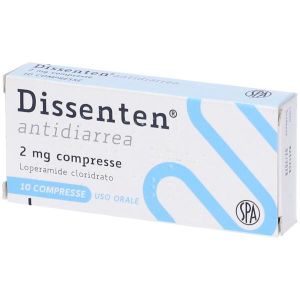Ship in Europe, Find out rates!
Language
Antibiotic Products Company Dissenten Antidiarrhea 10 Tablets Of 2mg

Regular Price
€8.90
Special Price
€6.93
-22%
Save: €1.97
In stock
Recent lowest price:
€6.93
- box Delivery in Italy in 24/48 and free returns
- star3.000+ positive reviews
- dropboxOver 60,000 products in the catalog
Dissenten Antidiarrea 2mg 10 Compresse
Manufacturer
SPA
SKU
043905013
Active principle
LOPERAMIDE CLORIDRATO
NAME
DISSENTEN ANTIDIARREA 2 MG TABLETS
PHARMACOTHERAPEUTIC CATEGORY
Anti-propulsants.
ACTIVE PRINCIPLES
Loperamide hydrochloride.
EXCIPIENTS
Magnesium stearate; microgranular cellulose.
INDICATIONS
Symptomatic treatment of acute diarrhea.
CONTRAINDICATIONS / SECONDARY EFFECT
Hypersensitivity to the active substance or to any of the listed excipients; contraindicated in children under 6 years. The medicine should not be used as primary therapy: in patients with acute dysentery, characterized by blood in the stool and high fever; in patients with acute ulcerative colitis; in patients with pseudomembranous colitis associated with the use of broad-spectrum antibiotics; in patients with bacterial enterocolitis caused by invasive organisms including Salmonella, Shigella and Campilobacter. In general, the use of the drug is contraindicated in all cases where inhibition of peristalsis must be avoided due to the possible risk of significant consequences such as ileus, megacolon and toxic megacolon. If you experience constipation, abdominal distension or ileus, stop the treatment immediately.
DOSAGE
Adults and children aged between 6 and 17 years: the initial dose is 2 tablets (4 mg) for adults and 1 tablet (2 mg) for children; thereafter 1 tablet (2 mg) after each subsequent evacuation of unformed (soft) faeces. The maximum daily dose for adults is 8 tablets (16 mg). For children, the dose should be related to body weight (3 tablets / 20 kg) but should not exceed a maximum of 8 tablets per day. Decrease the dose when the stool is normalized and stop treatment in case of constipation. Do not use for more than two days. The tablets should be taken with some liquid. Children under 6 years of age: the drug should not be used in children under 6 years of age. Elderly: No dose adjustment is necessary. Renal impairment: no dose adjustment is necessary. Hepatic impairment: Although no pharmacokinetic data are available in patients with hepatic impairment, the drug should be used with caution in these patients due to impaired first pass metabolism.
STORAGE
No special storage precautions.
WARNINGS
Treatment of diarrhea with loperamide hydrochloride is symptomatic only. Whenever an underlying etiology can be determined, specific treatment should be given when appropriate. Fluid and electrolyte depletion may occur in patients with diarrhea, especially children. In these cases the most important countermeasure is the administration of adequate replacement therapy based on fluids and electrolytes. It is advisable to suspend treatment with the drug if there is no improvement in clinical symptoms within 48 hours after the start of therapy and the patient should consult his doctor. AIDS patients treated with the drug for diarrhea should stop therapy at the first signs of abdominal distension. In these patients with infectious colitis of bacterial or viral origin, treated with loperamide hydrochloride, there have been isolated cases of constipation with an increased risk of toxic megacolon. Loperamide hydrochloride is subject to an intense first pass metabolism. The drug should be used with caution in patients with hepatic insufficiency as it can lead to relative overdose with CNS toxicity. In children between 6 and 12 years of age, the medicine should only be used under medical supervision. Cardiac events including QT prolongation and torsades de pointes have been reported in association with overdose. Some cases have been fatal. Patients should not exceed the recommended dose and / or extend the duration of therapy.
INTERACTIONS
Non-clinical data demonstrated that loperamide is a substrate of P-glycoprotein. Concomitant administration of loperamide (single 16 mg dose) with quinidine or ritonavir, both inhibitors of P-glycoprotein, resulted in a 2 to 3-fold increase in plasma levels of loperamide. The clinical relevance of this pharmacokinetic interaction with P-glycoprotein inhibitors when loperamide is administered at recommended doses is unknown. Concomitant administration of loperamide (single 4 mg dose) and itraconazole, an inhibitor of CYP3A4 and P-glycoprotein, showed a 3 to 4-fold increase in plasma concentrations of operamide. In the same study, gemfibrozil, a CYP2C8 inhibitor, increased plasma concentrations of loperamide approximately 2-fold. The combination of itraconazole and gemfibrozil showed a 4-fold increase in peak plasma levels of loperamide and a 13-fold increase in total plasma exposure. These increases were not associated with central nervous system (CNS) effects, as detected by psychomotor tests (e.g. subjective sleepiness and the Digit Symbol Substitution Test). Concomitant administration of loperamide (16 mg single dose) and ketoconazole, an inhibitor of CYP3A4 and P-glycoprotein, resulted in a 5-fold increase in plasma concentrations of loperamide. This increase was not associated with an increase in pharmacodynamic effects, as detected by pupillometry. Concomitant treatment with oral desmopressin resulted in a 3-fold increase in plasma concentrations of desmopressin, presumably due to a slowing of gastrointestinal motility. Treatment with substances with similar pharmacological properties can enhance the effect of loperamide and drugs that accelerate intestinal transit can decrease its effect. The concomitant use of CYP 450 inhibitors is not recommended.
SIDE EFFECTS
Adults and children aged> = 12 years: The safety of loperamide hydrochloride was evaluated in 3076 adults and children aged> = 12 years who participated in 31 controlled and uncontrolled clinical trials with haloperamide hydrochloride used for the treatment of diarrhea. Of these, 26 studies were on acute diarrhea (N = 2755) and 5 on chronic diarrhea (N = 321). The most commonly reported adverse drug reactions (ADRs) (i.e. with an incidence> = 1%) in clinical trials with loperamide hydrochloride for the treatment of acute diarrhea were: constipation, flatulence, headache and nausea. In clinical trials for the treatment of chronic diarrhea the most commonly reported ADRs (i.e. with an incidence> = 1%) were flatulence, constipation, nausea and dizziness. The frequency categories presented use the following convention: very common (> = 1/10), common (> = 1/100, <1/10), uncommon (> = 1/1000, <1/100), rare ( > = 1 / 10,000, <1/1000) and very rare (<1 / 10,000). >> Frequency of adverse reactions reported with the use of loperamide hydrochloride from clinical trials in adults and children aged> = 12 years. >> Acute diarrhea. Nervous system disorders. Common: headache; uncommon: dizziness. Gastrointestinal disorders. Common: constipation, nausea, flatulence; uncommon: abdominal pain, abdominal discomfort, dry mouth, upper abdominal pain, vomiting; rare: abdominal distension. Skin and subcutaneous tissue disorders. uncommon: rash. >> Chronic diarrhea. Nervous system disorders. Uncommon: headache; common: dizziness. Gastrointestinal disorders. Common: constipation, nausea, flatulence; uncommon: abdominal pain, abdominal discomfort, dry mouth, upper abdominal pain, vomiting, dyspepsia. >> Loperamide hydrochloride, data of post-marketing adverse reactions. Immune system disorders: hypersensitivity reaction, anaphylactic reaction (including anaphylactic shock), anaphylactoid reaction. Nervous system disorders: drowsiness, loss of consciousness, stupor, depression of consciousness levels, hypertonia, abnormal coordination. Eye disorders: miosis. Gastrointestinal disorders: ileus (including paralytic ileus), megacolon (including toxic megacolon), glossodynia. Skin and subcutaneous tissue disorders: bullous rash syndrome (including Stevens-Johnson syndrome, toxic epidermal necrolysis and erythema multiforme), angioedema, urticaria, pruritus. Renal and urinary disorders: urinary retention. General Disorders and Administration Site Conditions: Fatigue. Pediatric population: the safety of loperamide hydrochloride was evaluated in 607 patients aged 10 days to 13 years who participated in 13 controlled and uncontrolled clinical trials with loperamide hydrochloride used for the treatment of acute diarrhea. In general, the ADR profile in this patient population was similar to that observed in clinical trials with loperamide hydrochloride in adults and children aged 12 years and older. The reporting of suspected adverse reactions that occur after the authorization of the drug is important, as it allows continuous monitoring of the benefit / risk ratio of the drug.
PREGNANCY AND BREASTFEEDING
Administration of the drug during pregnancy and breastfeeding is not recommended. Pregnant or lactating women should therefore consult their doctor for appropriate treatment.
DISSENTEN ANTIDIARREA 2 MG TABLETS
PHARMACOTHERAPEUTIC CATEGORY
Anti-propulsants.
ACTIVE PRINCIPLES
Loperamide hydrochloride.
EXCIPIENTS
Magnesium stearate; microgranular cellulose.
INDICATIONS
Symptomatic treatment of acute diarrhea.
CONTRAINDICATIONS / SECONDARY EFFECT
Hypersensitivity to the active substance or to any of the listed excipients; contraindicated in children under 6 years. The medicine should not be used as primary therapy: in patients with acute dysentery, characterized by blood in the stool and high fever; in patients with acute ulcerative colitis; in patients with pseudomembranous colitis associated with the use of broad-spectrum antibiotics; in patients with bacterial enterocolitis caused by invasive organisms including Salmonella, Shigella and Campilobacter. In general, the use of the drug is contraindicated in all cases where inhibition of peristalsis must be avoided due to the possible risk of significant consequences such as ileus, megacolon and toxic megacolon. If you experience constipation, abdominal distension or ileus, stop the treatment immediately.
DOSAGE
Adults and children aged between 6 and 17 years: the initial dose is 2 tablets (4 mg) for adults and 1 tablet (2 mg) for children; thereafter 1 tablet (2 mg) after each subsequent evacuation of unformed (soft) faeces. The maximum daily dose for adults is 8 tablets (16 mg). For children, the dose should be related to body weight (3 tablets / 20 kg) but should not exceed a maximum of 8 tablets per day. Decrease the dose when the stool is normalized and stop treatment in case of constipation. Do not use for more than two days. The tablets should be taken with some liquid. Children under 6 years of age: the drug should not be used in children under 6 years of age. Elderly: No dose adjustment is necessary. Renal impairment: no dose adjustment is necessary. Hepatic impairment: Although no pharmacokinetic data are available in patients with hepatic impairment, the drug should be used with caution in these patients due to impaired first pass metabolism.
STORAGE
No special storage precautions.
WARNINGS
Treatment of diarrhea with loperamide hydrochloride is symptomatic only. Whenever an underlying etiology can be determined, specific treatment should be given when appropriate. Fluid and electrolyte depletion may occur in patients with diarrhea, especially children. In these cases the most important countermeasure is the administration of adequate replacement therapy based on fluids and electrolytes. It is advisable to suspend treatment with the drug if there is no improvement in clinical symptoms within 48 hours after the start of therapy and the patient should consult his doctor. AIDS patients treated with the drug for diarrhea should stop therapy at the first signs of abdominal distension. In these patients with infectious colitis of bacterial or viral origin, treated with loperamide hydrochloride, there have been isolated cases of constipation with an increased risk of toxic megacolon. Loperamide hydrochloride is subject to an intense first pass metabolism. The drug should be used with caution in patients with hepatic insufficiency as it can lead to relative overdose with CNS toxicity. In children between 6 and 12 years of age, the medicine should only be used under medical supervision. Cardiac events including QT prolongation and torsades de pointes have been reported in association with overdose. Some cases have been fatal. Patients should not exceed the recommended dose and / or extend the duration of therapy.
INTERACTIONS
Non-clinical data demonstrated that loperamide is a substrate of P-glycoprotein. Concomitant administration of loperamide (single 16 mg dose) with quinidine or ritonavir, both inhibitors of P-glycoprotein, resulted in a 2 to 3-fold increase in plasma levels of loperamide. The clinical relevance of this pharmacokinetic interaction with P-glycoprotein inhibitors when loperamide is administered at recommended doses is unknown. Concomitant administration of loperamide (single 4 mg dose) and itraconazole, an inhibitor of CYP3A4 and P-glycoprotein, showed a 3 to 4-fold increase in plasma concentrations of operamide. In the same study, gemfibrozil, a CYP2C8 inhibitor, increased plasma concentrations of loperamide approximately 2-fold. The combination of itraconazole and gemfibrozil showed a 4-fold increase in peak plasma levels of loperamide and a 13-fold increase in total plasma exposure. These increases were not associated with central nervous system (CNS) effects, as detected by psychomotor tests (e.g. subjective sleepiness and the Digit Symbol Substitution Test). Concomitant administration of loperamide (16 mg single dose) and ketoconazole, an inhibitor of CYP3A4 and P-glycoprotein, resulted in a 5-fold increase in plasma concentrations of loperamide. This increase was not associated with an increase in pharmacodynamic effects, as detected by pupillometry. Concomitant treatment with oral desmopressin resulted in a 3-fold increase in plasma concentrations of desmopressin, presumably due to a slowing of gastrointestinal motility. Treatment with substances with similar pharmacological properties can enhance the effect of loperamide and drugs that accelerate intestinal transit can decrease its effect. The concomitant use of CYP 450 inhibitors is not recommended.
SIDE EFFECTS
Adults and children aged> = 12 years: The safety of loperamide hydrochloride was evaluated in 3076 adults and children aged> = 12 years who participated in 31 controlled and uncontrolled clinical trials with haloperamide hydrochloride used for the treatment of diarrhea. Of these, 26 studies were on acute diarrhea (N = 2755) and 5 on chronic diarrhea (N = 321). The most commonly reported adverse drug reactions (ADRs) (i.e. with an incidence> = 1%) in clinical trials with loperamide hydrochloride for the treatment of acute diarrhea were: constipation, flatulence, headache and nausea. In clinical trials for the treatment of chronic diarrhea the most commonly reported ADRs (i.e. with an incidence> = 1%) were flatulence, constipation, nausea and dizziness. The frequency categories presented use the following convention: very common (> = 1/10), common (> = 1/100, <1/10), uncommon (> = 1/1000, <1/100), rare ( > = 1 / 10,000, <1/1000) and very rare (<1 / 10,000). >> Frequency of adverse reactions reported with the use of loperamide hydrochloride from clinical trials in adults and children aged> = 12 years. >> Acute diarrhea. Nervous system disorders. Common: headache; uncommon: dizziness. Gastrointestinal disorders. Common: constipation, nausea, flatulence; uncommon: abdominal pain, abdominal discomfort, dry mouth, upper abdominal pain, vomiting; rare: abdominal distension. Skin and subcutaneous tissue disorders. uncommon: rash. >> Chronic diarrhea. Nervous system disorders. Uncommon: headache; common: dizziness. Gastrointestinal disorders. Common: constipation, nausea, flatulence; uncommon: abdominal pain, abdominal discomfort, dry mouth, upper abdominal pain, vomiting, dyspepsia. >> Loperamide hydrochloride, data of post-marketing adverse reactions. Immune system disorders: hypersensitivity reaction, anaphylactic reaction (including anaphylactic shock), anaphylactoid reaction. Nervous system disorders: drowsiness, loss of consciousness, stupor, depression of consciousness levels, hypertonia, abnormal coordination. Eye disorders: miosis. Gastrointestinal disorders: ileus (including paralytic ileus), megacolon (including toxic megacolon), glossodynia. Skin and subcutaneous tissue disorders: bullous rash syndrome (including Stevens-Johnson syndrome, toxic epidermal necrolysis and erythema multiforme), angioedema, urticaria, pruritus. Renal and urinary disorders: urinary retention. General Disorders and Administration Site Conditions: Fatigue. Pediatric population: the safety of loperamide hydrochloride was evaluated in 607 patients aged 10 days to 13 years who participated in 13 controlled and uncontrolled clinical trials with loperamide hydrochloride used for the treatment of acute diarrhea. In general, the ADR profile in this patient population was similar to that observed in clinical trials with loperamide hydrochloride in adults and children aged 12 years and older. The reporting of suspected adverse reactions that occur after the authorization of the drug is important, as it allows continuous monitoring of the benefit / risk ratio of the drug.
PREGNANCY AND BREASTFEEDING
Administration of the drug during pregnancy and breastfeeding is not recommended. Pregnant or lactating women should therefore consult their doctor for appropriate treatment.
| Destination | Cost | Detail |
|---|---|---|
| Italy | €5,90* | 24/72H |
| Austria, France, Germany, Slovenia | € 13* | 3 days |
| Belgium, Luxembourg, Portugal, Netherlands, Spain | € 14* | 4 days |
| Bulgary, Cechia, Hungary, Poland, Romania, Slovakia | € 19* | 5 days |
| Denmark, Estonia, Finland, Ireland, Lithuania, Latvia ,Sweden | € 22* | 5 days |
| United Kingdom, Switzerland, Greece, Malta/td> | € 30* | 7 days |
| Canada | € 40 | 7 Days |
European shipments with express courier: FedEx, MBE, DHL
*For the shipment outside band B ther's an extra cost of 22€ *For the shipment outside band C ther's an extra cost of 30€ Delivery Times exclude Saturday and Holidays
For Islands and Areas of difficult Accessibility the shipments are made in 72 hours and the cost will be increased by 15€
The images of the products shown on our site are purely indicative and may differ in shape, color, text and packaging shown on them. Given the difficulty of updating all the products on our site in real time or any errors, XFarma.it, all products will be identified through SKU MINSAN (code of the Ministry of Health).


